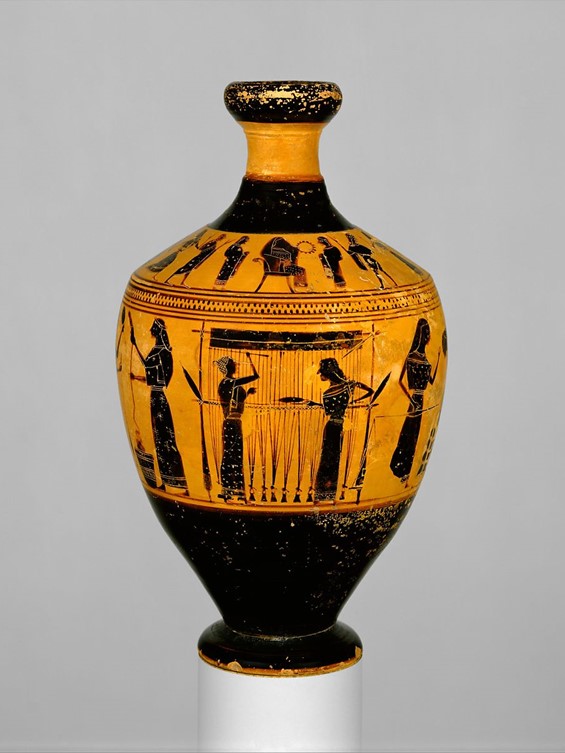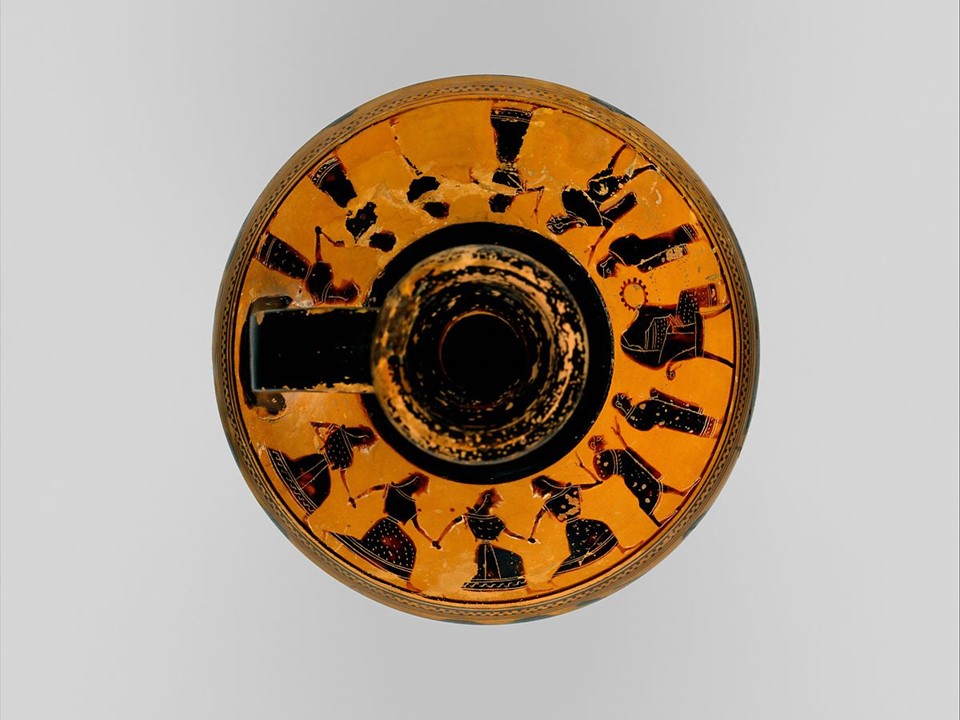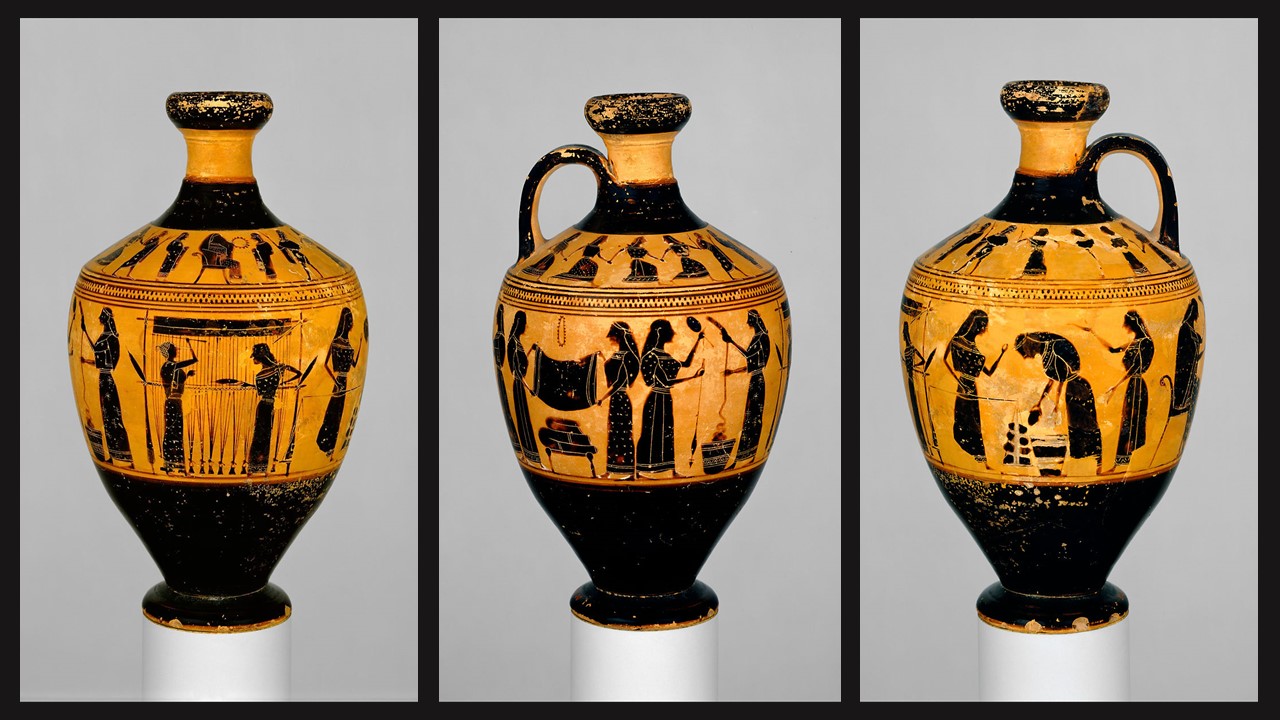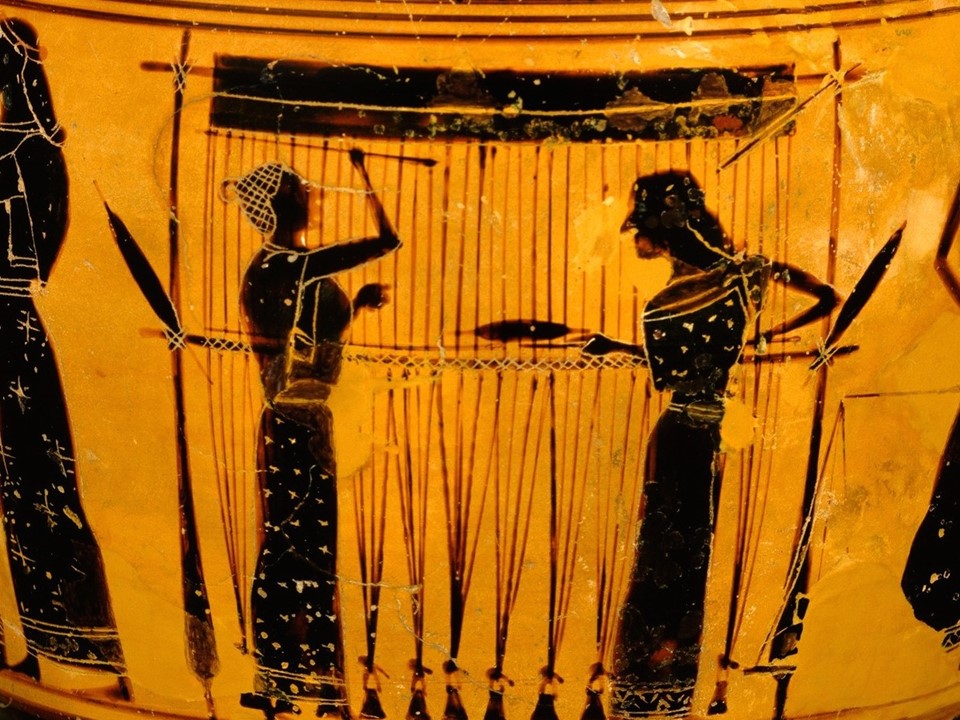
Terracotta Black-Figure Lekythos (oil flask) depicting the preparation of wool and the weaving of cloth, ca. 550–530 BC, H. 17.15 cm, the MET, NY, USA
https://www.metmuseum.org/art/collection/search/253348?searchField=All&sortBy=Relevance&high=on&ao=on&showOnly=openAccess&ft=*&offset=560&rpp=80&pos=573
First some god breathed the thought in my heart to set up a great web in my halls and fall to weaving a robe—fine of thread was the web and very wide; and I straightway spoke among them: ‘Young men, my wooers, since goodly Odysseus is dead, be patient, though eager for my marriage, until I finish this robe—I would not that my spinning should come to naught—a shroud for the lord Laertes against the time when the fell fate of grievous death shall strike him down; lest any one of the Achaean women in the land should be wroth with me, if he were to lie without a shroud, who had won great possessions…’ spoke Penelope in Homer’s Odyssey (Book 19, 138-147). Weaving in Ancient Greece is a fascinating topic to explore… https://www.perseus.tufts.edu/hopper/text?doc=Perseus%3Atext%3A1999.01.0136%3Abook%3D19%3Acard%3D89
Searching for information on the famous Black-Figure Lekythos by Amasis Painter at the Metropolitan Museum of Art in New York of women making woolen cloth, I came across a site I would like to share… and acting more like a Curator rather than a Teacher, I present you with THE PENELOPE PROJECT site I am fascinated about. I like the way it was founded, how it operates, and the wealth of information on the topic of Weaving in Ancient Greece. I wish I was a member of this amazing group of scholars… who at the Institute for the History of Technology and Science at Deutsches Museum in Munich… aim to integrate ancient weaving into the history of science and technology, especially digital technology… encompasses the investigation of ancient sources as well as practices and technological principles of ancient weaving… and setting up in Munich a PENELOPE laboratory they detect the models and topologies of weaves and develop codes to make them virtually explorable. https://penelope.hypotheses.org/It is worth exploring and you will most definitely enjoy browsing it!
Back to the Black-Figure Lekythos by Amasis Painter at the Metropolitan Museum of Art in New York of women making woolen cloth… I love every decorated part f it… from top to bottom! https://www.metmuseum.org/art/collection/search/253348?searchField=All&sortBy=Relevance&high=on&ao=on&showOnly=openAccess&ft=*&offset=560&rpp=80&pos=573

Terracotta Black-Figure Lekythos (oil flask) depicting the preparation of wool and the weaving of cloth (neck view of women dancing), ca. 550–530 BC, H. 17.15 cm, the MET, NY, USA
https://www.metmuseum.org/art/collection/search/253348?searchField=All&sortBy=Relevance&high=on&ao=on&showOnly=openAccess&ft=*&offset=560&rpp=80&pos=573
According to the Metropolitan experts, on the shoulder, a seated woman, perhaps a goddess, is approached by four youths and eight dancing maidens. The depicted dance is a group performance of women, and it looks synchronized, with pre-planned movements. Could this scene depict a women’s religious dance… something like the Ierakio (Ιεράκειο) performed in honour of the goddess Hera? https://books.google.gr/books?id=fkSuDwAAQBAJ&pg=PA84&lpg=PA84&dq=%CE%99%CE%B5%CF%81%CE%B1%CE%BA%CE%B9%CE%BF+(%CE%99%CE%B5%CF%81%CE%AC%CE%BA%CE%B5%CE%B9%CE%BF)+dance&source=bl&ots=0Dt8N4ENqf&sig=ACfU3U36X2qnvm01sqhovtng8da1yfMc1g&hl=el&sa=X&ved=2ahUKEwjmkIyAqdrxAhVE_7sIHSydAUAQ6AEwD3oECAoQAw#v=onepage&q=%CE%99%CE%B5%CF%81%CE%B1%CE%BA%CE%B9%CE%BF%20(%CE%99%CE%B5%CF%81%CE%AC%CE%BA%CE%B5%CE%B9%CE%BF)%20dance&f=false

Terracotta Black-Figure Lekythos (oil flask) depicting the preparation of wool and the weaving of cloth (three sides of the pot’s body), ca. 550–530 BC, H. 17.15 cm, the MET, NY, USA
https://www.metmuseum.org/art/collection/search/253348?searchField=All&sortBy=Relevance&high=on&ao=on&showOnly=openAccess&ft=*&offset=560&rpp=80&pos=573
On the body of the Metropolitan Lekythos, women are making woolen cloth. In the center, two women work at an upright loom. To the right, three women weigh wool. Farther to the right, four women spin wool into yarn, while between them finished cloth is being folded. https://www.metmuseum.org/art/collection/search/253348?searchField=All&sortBy=Relevance&high=on&ao=on&showOnly=openAccess&ft=*&offset=560&rpp=80&pos=573

Terracotta Black-Figure Lekythos (oil flask) depicting the preparation of wool and the weaving of cloth (detail), ca. 550–530 BC, H. 17.15 cm, the MET, NY, USA
https://www.metmuseum.org/art/collection/search/253348?searchField=All&sortBy=Relevance&high=on&ao=on&showOnly=openAccess&ft=*&offset=560&rpp=80&pos=573
Making cloth is one of the most important responsibilities women of Ancient Greece were entrusted with. They were responsible to create the clothing worn by all members of their family, as well as textiles for household needs. Their craftsmanship was testimony to their industriousness, ‘value’ as a wife, and ‘beauty’ as a woman. According to Homer, making cloth, was the work of elite women: Helen, Andromache, Penelope, Arete, as well as goddesses. Circe and Calypso wove, to say nothing of Athene herself, warrior and weaver both. They wove patterned cloth which, in the case of the first three, expressed their own qualities, as well as their relationship to particular men. Helen weaves the story of the Trojan War, Andromache weaves flowery love charms, not knowing that Hector is dead, and Penelope weaves a stratagem to forestall betrayal of Odysseus… https://chs.harvard.edu/susan-t-edmunds-picturing-homeric-weaving/
The Metropolitan Lekythos is attributed to Amasis the Painter, an artist whose real name is a mystery, known today by the name of the Potter Amasis whose works he most often decorated. They were both leading black-figure artists active around 550–510 BC. This Metropolitan Lekythos displays characteristics the Amasis the Painter incorporated in his oeuvre like symmetry, precision, clarity, harmony, and a preference to small scale figures.
For a PowerPoint on the work of Amasis, please… Check HERE!
An interesting 1985 Book to read, prepared to accompany an exhibition held at the Metropolitan Museum of Art, the Toledo Museum of Art, and the Los Angeles County Museum of Art in 1985-1986… is titled The Amasis Painter and His World: Vase Painting in Sixth-Century B.C. Athens by Dietrich von Bothmer and Alan L. Boegehold, and you can download it… https://www.getty.edu/publications/virtuallibrary/0500234434.html